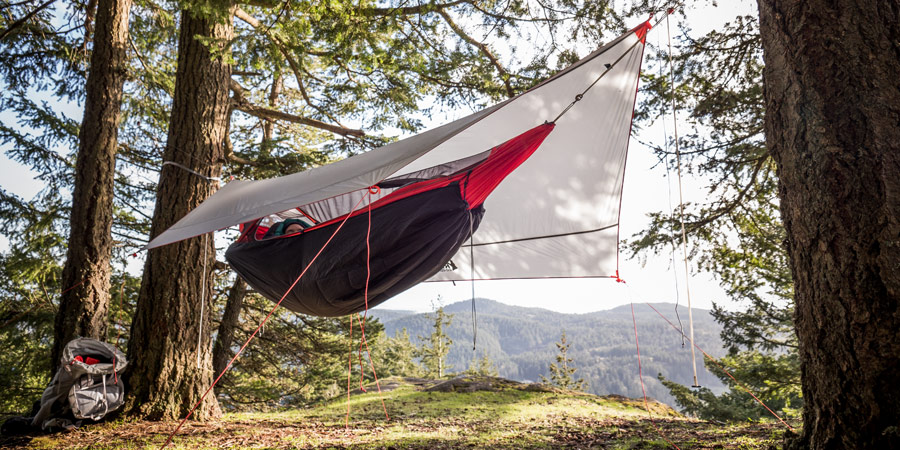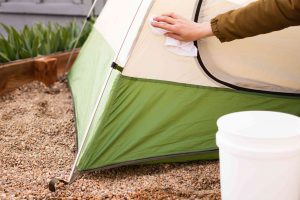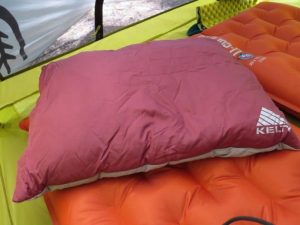How To Clean and Store Your Hammock: The Ultimate Guide
If you’re looking for a way to keep your hammock clean and fresh, then this is the article for you! We will discuss in detail how to clean and wash your hammocks. You’ll learn about all of the steps that are needed in order to properly maintain your hammock. Once we’ve gone through these steps, we’ll give you some tips on what products can be used as well as where to buy them from.
Table of Contents
How often should I wash my hammock?
It really depends on how often you use your hammock and what type of conditions it is exposed to.
Most people find that once a season or every couple of months works best for them based on the amount of dirt, in which build up in their hammocks from daily use
If you’re a person that spends a considerable amount of time in your hammock, then it may be beneficial to wash it more often.

Supplies You Will Need
There are some supplies that you will need before cleaning your hammock. They include:
- A bucket with warm water
- A mild detergent (dish soap is fine)
- Scrub Glove
- Soft bristle toothbrush
- Bucket for rinsing
- Hang to dry or use a clothesline (if it’s cold outside, then the dryer can be used)

How To Clean Your Hammock
There are several steps that need to be taken in order for you to clean your hammock.
First Step Shake Dirt Off
You’ll want to shake all of the excess dirt, leaves, and debris off your hammock. This will help with getting it ready for cleaning by removing anything that is in or on top of your hammock that you don’t want to get wet or dirty.
Second Step Mix Water and Detergent
Once you’ve shaken the excess dirt off your hammock, then it’s time to get everything mixed together. All you’ll need is a bucket of warm water (it doesn’t have to be extremely hot). Add in some dish soap or mild detergent into the water until fully combined with no bubbles remaining. You want the water to be slightly soapy, but not too sudsy.
Third Step: Washing The Hammock
You’ll now want to take your scrub glove and begin washing down your hammock with the mixture of warm water and soap that you just created. Make sure that all areas are clean from dust, dirt, leaves.
Note: Make sure you get all of the areas including underneath and inside your hammocks.
Fourth Step: Rinse The Hammcok Out
Once you’ve finished washing down your hammock, then it’s time to rinse it out. This is important because if any soap or suds are left behind on the fabric that could cause issues with the fabric and the stitching. To do this, just take your bucket of water that you used to clean your hammock with and rinse it out thoroughly until all excess soap is removed from the fabric.
Fifth Step: Drying The Hammock
You’ll now want to dry off your hammock once complete rinsing has taken place. There are two ways you can do this:
- Outdoor: If it’s a nice day outside and you want to air dry your hammock, then make sure that the area where you place your hammock is under some shade. Hang it on a clothesline or tree branch if possible.
- Indoor: If weather isn’t appropriate for outdoor drying of your hammock, then you can use the dryer. Make sure to use the lowest setting and put a couple of clean tennis balls or dryer balls into your clothes dryer in order to reduce any chance of your hammock shrinking once it’s finished drying (if you don’t have these, then towels can be used).
Sixth Step: Re-Attach Your Hangers
Once the hammock is completely dry, you’ll want to reattach your hangars. This can be done by simply placing them back on where they belong and adjusting as necessary until it’s properly attached.

Tips
- Use towels or washcloths if you need help scrubbing off any debris from your hammock’s surface. Remember that there is no detergent in the soapy water – only use this as an alternative to the water itself.
- If you are hanging your hammock outside, make sure that it is in a location where there will be some shade given by trees or something else shading it from sunlight at all times of the day. If not, then use the dryer on low heat with clean tennis balls inside (or towels) for faster drying time. If you have a mild detergent with fabric softener included in the mix, then this is okay to use on your hammock. Just make sure that it’s been rinsed out thoroughly before hanging outside or putting it into the dryer
- Don’t forget to reattach any hooks or carabiners if they’ve fallen off during cleaning

What to Avoid
- When in doubt, do not use a higher heat setting in the dryer. If you have any doubts about what kind of detergent to use on your hammock or if it’s safe to be used at all, then don’t risk getting your hammock dirty and go with something else that is safer for fabric overall.
- Don’t use any bleach or harsh chemicals. This can damage your hammock and surrounding area if not used properly
- Don’t scrub too hard on the fabric of your hammock as this may cause it to lose some color and fade more easily over time
- If you want, make sure that there is a clean towel underneath while washing in order to protect your surface from any excess water.

How To Store Your Hammock
If you’re looking to store your hammock then make sure that it’s completely dry before packing away. Before placing into storage, use a cotton cloth or towel and gently dust down your hammock with an upward motion so as not to push dirt further in-between the fabric.
In order to keep your hammock from getting dusty or dirty in storage, make sure that you store it properly and avoid any direct sunlight exposure as this can damage your hammock’s color over time if not cared for appropriately. If you have a place where there is no light whatsoever (like a closet), then this will be best for your hammock so it doesn’t fade or lose its color.

Cleaning Tips For Different Types of Hammocks
- Hammocks with wooden spreader bars: Since the wood is more porous, it’s a good idea to take extra care when cleaning these. Make sure that all soap has been rinsed out properly after washing and if you have any mild detergent with fabric softener included in the mix, then this can also be used on your wooden spreader bars.
- Hammocks with rope for hanging: These are easier to clean since there are no moving parts or any fabric that can be damaged by bleach or harsh chemicals, but make sure to use a mild detergent on the ropes only – not the actual hammock itself! If you have one of these types of hammocks, then it’s a good idea to keep an eye on the color of your hammock since some milder detergents may have fabric softener in them. This can fade or remove colors over time if not used carefully.
- Hammocks with removable fabrics for washing: These are easier to clean given that you can take out the fabric and wash it separately. If you have one of these types then just be aware that the washing machine can cause some color loss to your fabric over time if not used carefully – especially on bright colors like red, orange, or yellow.

Repairing Strigs And Ropes
If you’re looking to repair the strings or ropes of your hammock, then this is fairly easy. Just make sure that your string isn’t too damaged and any fabric tears are no longer than an inch in length – otherwise, they’ll become bigger over time. It’s best to replace them with new rope if there are any signs of fraying.
You’ll need:
- A sharp knife
- Some rope or string (depending on what you’re using to repair the hammock)
Steps: Take your sharp knife and cut off any frayed parts of your string, but make sure that they aren’t too long so as not to cause any more damage when you start to tie the new knot. Start tying your knots with some string or rope of your own, making sure that you’re not using any excess length so as to avoid tangling up your hammock later on down the road.
If you have trouble getting these simple directions right then it’s best to contact a local hardware store for more help. They should be able to assist you with any questions or concerns that are related to hammock repair.
Broken Chain Attachments
If you have a hammock with chain attachments then it’s best to take these off so they don’t get damaged during the washing process. If your chains are metal, then simply remove them before putting them in the washing machine if you’re worried about any rusting or damage that can happen over time – this is especially important for wooden spreader bars since they’re more prone to damage.

Patching Up Holes And Tears
If you have any holes or tears in your hammock fabric, then it’s best to patch them up first before throwing the entire thing into the washing machine. This is only recommended for smaller patches of fabric though since some larger ones can cause more damage if they’re not fixed first – especially on bright colors like red or yellow.
To patch up any tears in your fabric, take some thread and needle (or if you don’t have these tools handy then a hot glue gun can also work) to seal off the edges of the hole so that they’re not fraying anymore. If there are still loose ends on either side after this process has been completed, then you can cut them off. If your patch is bigger than the hole itself, then just overlap some fabric over each other and sew a neat line so that it doesn’t unravel when in use.

FAQs
Q: Is it okay to put my hammock in the dryer?
A: No, never place your wet or damp hammock into a clothes dryer. This can cause shrinkage and damage during the drying process. If you have a wooden spreader bar then this can also warp due to extreme heat exposure over time as well.
Q: What is the best way to dry my hammock?
A: You can either hang it up outside in the shade or indoors near a window. Just make sure that there’s no direct sunlight exposure when you do this step since hot sun rays will cause excessive shrinking and damage if left for too long. It may take anywhere from a day to a week for your hammock to completely dry out depending on the weather conditions.
Q: How long should I leave my hammock in the washing machine?
A: It’s best to let your hammock soak for at least an hour or two before throwing it into a wash cycle. If you want to clean more stubborn stains and dirt away, then you can add some laundry detergent during this time as well. However, it’s best not to leave your hammock in the washing machine for too long since this can cause more damage than good.
Q: What is the best kind of detergent I should use?
A: You’ll want to avoid using fabric softener or any bleach products when cleaning your canvas, so only opt for laundry soap instead. Just make sure to use a small amount of this since too much can cause fabric discoloration and damage.
Q: How should I dry my wet hammock?
A: Make sure that you’re not putting your damp or wet hammock into a clothes dryer because this can cause damage to the fabric and spreader bars. It may take anywhere from one day to a week for it to completely dry out depending on weather conditions, so make sure to follow the proper drying instructions in order to prevent damage.
Q: How can I repair a tear in my hammock fabric?
A: If you have any tears or holes in your hammock, then it’s best to patch them up before placing them into a washing machine – especially if they’re bigger than the actual hole itself. If you don’t have any thread or needle on hand, then a hot glue gun can also work in place of this.
Q: How many hours should I leave my hammock to soak?
A: It’s best to let your hammock sit for at least an hour or two before beginning the washing process so that it has plenty of time to soak up the detergent and fabric softener. If you want to ensure that stubborn dirt particles are gone, then adding some laundry soap during this process is recommended as well. Just keep in mind that it may take anywhere from a day to a week for your hammock cushions to completely dry out depending on weather conditions – so always follow the proper drying instructions.
Q: What should I do if my fabric starts fading over time?
A: There are some things that you can try in order to get rid of any color loss, but it will depend on how badly the colors have faded. You may want to try and clean the fabric with color-safe bleach, or you can also add half a cup of vinegar to your washing machine when you run it for best results. If the fabric is still in good condition then you can also try adding half a cup of white vinegar to your machine when it’s on its normal cycle.
Q: Is it okay for my hammock to get wet?
A: Yes, a hammock is designed to get wet and dry out again. The only thing that you should be worried about is if your fabric starts to mold or mildew over time – this usually happens when there’s too much moisture left on the surface of the material because it can’t evaporate quickly enough. In order to avoid this from happening, you can use a clothesline to let it dry out faster instead of leaving it up against the wall.










